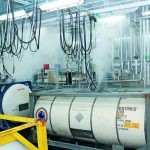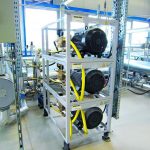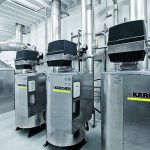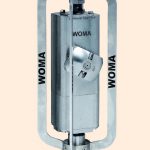Interior cleaning of transport, storage and production containers in the chemical industry can only take place efficiently in compliance with applicable standards and depending on individual conditions. The choice of the correct cleaning technology is influenced by the type of contamination, the shape and size of the container, the available access options and any components installed in the container. In particular, cleaning with automated high-pressure units is becoming more and more widely used due to the shorter production downtime and related cost savings.
Automated system concepts reduce production downtime
The concept must fit
Interior cleaning of transport, storage and production containers in the chemical industry can only take place efficiently in compliance with applicable standards and depending on individual conditions. The choice of the correct cleaning technology is influenced by the type of contamination, the shape and size of the container, the available access options and any components installed in the container. In particular, cleaning with automated high-pressure units is becoming more and more widely used due to the shorter production downtime and related cost savings.
The required degree of cleanliness must be determined prior to cleaning containers. A distinction is made here between visually clean containers, which are sufficient for similar products, chemically clean containers where a tank inspection is due and biologically clean containers. The different standards demanded by the respective stakeholders are important in this respect. These include the SQAS (Safety and Quality Assessment System), a standard of the European Chemical Industry Council Cefic, and the ECD (European Cleaning Document), which is issued jointly by the DVTI (German association for tank interior cleaning) and the European umbrella organisation (EFTCO). The SQAS is intended for logistics service providers and is used to assess hazardous products, mainly for quality, safety and environmental compatibility. In addition to the actual transport service, it also includes tank cleaning. The ECD has established itself as an industry cleaning standard throughout Europe. Many food and chemical companies today require an ECD before tankers or tank containers can be released for filling. The food industry, in particular, is an essential part of the so-called HACCP (Hazard Analysis and Critical Control Points) concept, which is a preventative system intended to ensure the safety of food products and consumers. In the chemical industry, cleaning in potentially explosive atmospheres is frequently unavoidable. In this case, the Atex Product Directive 94/9/EC must be complied with.
In order to achieve the best possible cleaning result, a customer-specific concept must be developed. Depending on the contamination properties, the application and various other aspects, four cleaning factors – mechanics, temperature, chemicals and cleaning duration – must be taken into account. The nozzle pressure, flow rate, temperature, cleaning agent and contact time must therefore be balanced as far as possible. The nozzle pressure and flow rate initially determine the impact pressure. This largely serves to break open the dirt layer and dislodge it from the surface. The flow rate of the cleaning medium is crucial for the removal of dislodged dirt. It is thus necessary to clarify whether a high-pressure cleaning system operating at up to 200 bar is sufficient or if it must be resorted to an ultra-high-pressure technology with pressures up to 1500 bar for stubborn dirt. Warm or hot water and alkaline cleaning agents can normally be utilised to remove grease or products containing mineral oil. Other substances that swell or clump at high temperatures (e.g. protein, starch) are cleaned cold, whereas lime or amines can be removed with acidic cleaning agents. Other typical materials in the chemical industry such as plastic monomers, which react with water and decompose, are cleaned with solvents. The cleaning duration must likewise be considered in order to keep the consumption of resources to a minimum. The wastewater volume and disposal costs should be reduced wherever feasible, for example.
Against this background, manual cleaning can normally be ruled out. Automated cleaning systems are required to meet the increasing quality requirements of the chemical industry. Manual cleaning is often not permitted either, as cleaning personnel tend to be exposed to risks, e.g. harmful paint and solvent fumes. Manual cleaning simultaneously involves high personnel costs.
Four components
A modern high-pressure cleaning system always consists of four main components. These components must be perfectly balanced to suit the individual application.
High-pressure units are at the heart of any container cleaning system. Different types are available depending on the cleaning medium and application. The question here is whether a stationary or a mobile system is the better solution. Where tanks and containers are spaced far apart, a mobile high-pressure pump is always preferable to avoid costly piping. In the paint and petrochemical industry in particular, where product is recirculated, it is important to ensure that high-pressure pumps are provided with special seals and a leakage return, both of which prevent risks to operating personnel and the environment.
The control and system concept includes various options allowing bespoke adaptation to customer-specific conditions – from simple remote control to visualisation on a touch panel or PCs integrated in technical control rooms. Automatic cleaning programs enable the acquisition of operating and cleaning data. Simple servicing and maintenance can also be carried out by the manufacturer’s employees with remote, external access to the system control.
Depending on the type of contamination, warm or hot water needs to be produced. In some cases, it is necessary to supply saturated steam (e.g. for preheating highly viscous substances) or hot air for drying. Energy systems and other components of the high-pressure cleaning system are subject to very strict requirements regarding their use in hazardous areas, they must comply with the Atex Product Directive 94/9/EC. Modern hot water systems should have an energy-saving mode to prevent the burner from cooling down between hot and cold water utilisation phases. Up to seven percent energy can be saved in this way compared to normal operation. A self-regulating control unit can additionally adjust the burner output to the water inlet temperature. This permits precise control of the set value, since fluctuating inlet temperatures are taken into account.
These must be suited to the size and type of the container as well as the materials to be cleaned. If a tank contains potentially explosive materials, it is essential to use products that comply with the Atex Directive. Interior cleaning heads conforming to these requirements are available for high-pressure and ultra-high pressure applications.
Since agitator vessels in the chemical industry often have numerous obstructions inside the tank, the use of spray heads with pivoting devices is recommended. The interior cleaning head can then be repositioned without having to be removed. Even corners and awkward areas in containers are accessible and spray shadow formation is prevented. Since the high-pressure jet works without contact, dirt entrainment is also reliably avoided. Added to these advantages are the short cleaning times and low fresh water consumption.
The sooner the better
As a general rule, the earlier and more regularly cleaning is carried out, the quicker the dirt can be removed. Particularly in the chemical industry, encrusted dirt layers involve longer cleaning times and therefore more production downtime. Nonetheless, good cleaning results can be achieved by using ultra-high pressure technology at pressures between 500 and 3000 bar to remove stubborn dirt.
Higher cleaning medium temperatures can lead to better cleaning results and reduce the cleaning time. However, these procedures can entail considerable costs. Solutions to increase economy and efficiency, e.g. by using wastewater heat, should therefore also be examined in terms of their effectiveness for specific projects. Numerous container cleaning solutions are offered today for the most diverse applications in the chemical industry. Before making a purchase, it is important to obtain a detailed analysis and advice from a system supplier, who assists with the design of the cleaning system and optimises it together with the customer in line with individual requirements. An inspection of reference systems can also be helpful – especially when it comes to sizing and designing the system solution.
www.cpp-net.com search: cpp0216kaercher
Maik Thomas
Maik Thomas
Head of Competence Center Industry,
Alfred Kärcher
Jochen Wöhrle
Jochen Wöhrle
Manager of Product Management Engineering / Service Industrial Projects,
Alfred Kärcher
Share:










